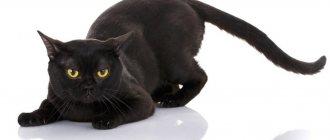- Cats
The most popular among pet breeds is the Russian Blue cat breed, which has hunting abilities, a unique character and an extraordinary appearance. The amazing features of this breed attracted attention even in ancient times of royalty and served as a truly royal gift to foreign ambassadors and high-ranking officials.
Russian blue cat price
Our charming beauty with emerald eyes is not as expensive as it might seem. The average price for Russian Blue cats should not fluctuate within large limits. You can see approximate prices for Russian blue cats in different countries below:
- Average price in Russia: 8,000 - 40,000 rubles.
- Average price in Ukraine: 1000 - 4000 UAH.
- Average price in the world: 400 — 700$
On the territory of the Russian Federation there is a rich supply of cats of this breed of various classes and ages, thanks to which buyers have the opportunity to choose. Catteries engaged in breeding Russian blue cats are available in many regions of the country, which is important when choosing, and it also facilitates delivery. Thanks to the popularity of Russian blue cats, it is quite possible to find an elite kitten in Russia.
Russian blue cats aged 3-4 months, born from an unplanned mating or not agreed upon with the club from purebred producers with documents, will cost approximately 4000-6000 rubles , moreover, from the documents for the pet itself, you can only count on a certificate of vaccinations and a veterinary passport. Cats from non-pedigreed parents have similar documents and cost from 2,500 rubles. Kittens born as a result of a planned and agreed mating, having all the necessary documents, are usually sold in nurseries (less often from private breeders) at a price of 10 to 40 thousand rubles .
How to choose a kitten
When choosing a kitten, you should be guided by the following tips:
- We need to adopt a three month old kitten. At this age you can judge how well he will meet the breed standards.
- The kitten's eyes should be pale green, marsh color. The color changes up to a year, so for now it will be faded. But if the kitten has yellowish eyes, it is better to refuse the purchase.
- The color of a three-month-old kitten will not change. Therefore, if now his coat is too dark and his undercoat is too thin, he will not get any prettier with age. White spots on the fur, if any, will not disappear. But you can ignore the small stripes in the tail area: they will disappear with age.
- The kitten should weigh 2 kg and be slender, elongated, with long legs and a flexible tail without kinks.
History of the origin of the breed
The name of this breed alone suggests the country of origin - this is our Mother Russia. According to one legend, this breed was formed in our north a couple of centuries ago. Arkhangelsk merchants and sailors brought Russian blue cats to England by sea. Cats with this blue-gray color were not unique in the British Isles. At that time, British, Maltese and Spanish cats had similar colors. At first, at cat shows, the Russian Blue was presented in the same group with British Shorthair cats. Only in the late 1930s, she was finally allocated to a separate class and received her own name, which stuck with her - Russian Blue cat. Although the color of her pole is more gray than blue. Agree that “Russian gray cat” does not sound so poetic.
The breed experienced a deep crisis after the devastating Second World War and almost completely disappeared. And then the breeders got to work. To restore the breed, they used the large British Shorthair cat breed and, in contrast to it, the slender, graceful Siamese cat breed with a light bone structure. It was under the influence of these two breeds that Russian Murkas acquired such a charming appearance, which we can observe to this day.
A new standard was written for the Russian Blue cat, and starting in the 60s, the popularity of this breed began to rapidly grow throughout the planet. Today, our gray-blue beauties are loved not only in their historical homeland, but also in Europe and the USA.
What diseases do Russian blue cats suffer from?
Animals that belong to this Russian Blue breed are in good health and have virtually no predisposition to genetic diseases. But this does not mean that they do not get sick at all. Like other cat breeds, Russian Blues can have digestive and genitourinary problems, suffer from infectious diseases, parasites and obesity.
Contact your veterinarian promptly. Photo: londondeposit / Depositphotos
Despite the good physical shape of representatives of this breed, if you suspect any ailments or sudden changes in behavior, you should definitely consult a specialist from a veterinary clinic. Diagnosing diseases at an early stage will help you take timely measures and avoid serious complications.
Provide assistance on time











